
Isopoda is an order of crustacean, which includes woodlice and their relatives. Members of this group are called Isopods and include both terrestrial and aquatic species. All have rigid, segmented exoskeletons, two pairs of antennae, seven pairs of jointed limbs on the thorax, and five pairs of branching appendages on the abdomen that are used in respiration. Females brood their young in a pouch under their thorax.
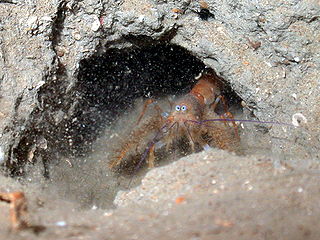
Furry lobsters are small decapod crustaceans, closely related to the slipper lobsters and spiny lobsters. The antennae are not as enlarged as in spiny and slipper lobsters, and the body is covered in short hairs, hence the name furry lobster. Although previously considered a family in their own right, the furry lobsters were subsumed into the family Palinuridae in 1990,. Subsequent molecular phylogenetics studies have confirmed that the furry lobsters genera don't form a natural group and were both nested among the spiny lobster genera in family Palinuridae. The family now includes the two furry lobster genera and ten spiny lobster genera.
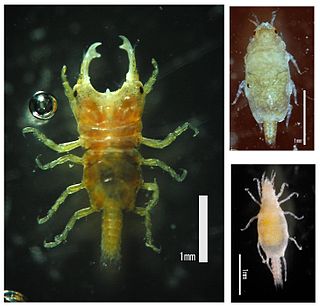
The Gnathiidae are a family of isopod crustaceans. They occur in a wide range of depths, from the littoral zone to the deep sea. The adults are associated with sponges and may not feed. The juvenile form is known as a 'praniza', and it is a temporary parasite of marine fish. These forms are not larvae; Gnathiidae instead become parasitic during the manca stage. Mancae of the Gnathiidae closely resemble the adult form, however they lack the final pair of pereiopods.
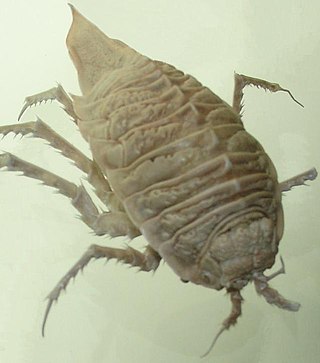
The Valvifera are marine isopod crustaceans. Valviferans are distinguished, however, by the flat, valve-like uropods which hinge laterally and fold inward beneath the rear part of their bodies, covering the pleopods. Some species are omnivorous, and serve as effective scavengers in the economy of the sea.

Styloniscus is a genus of woodlice in the family Styloniscidae. It contains the following species as of 2010:

The Cymothoidae are a family of isopods in the suborder Cymothoida found in both marine and freshwater environments. Cymoithoids are ectoparasites, usually of fish, and they include the bizarre "tongue-biter", which attaches to a fish's tongue, causing it to atrophy, and replaces the tongue with its own body. Ceratothoa oestroides is one of the most devastating ectoparasites in Mediterranean aquaculture. Around 40 genera and more than 380 species of cymothoid are recognised. Species of the Cymothoidae are generally found in warmer waters and rarely in the cool and cold climates.

A woodlouse is any crustacean belonging to the suborder Oniscidea within the order Isopoda. They get their name from often being found in old wood, and from louse, a parasitic insect, although woodlice are neither parasitic nor insects.

Agnaridae is a family of woodlice. They were formerly considered part of the Trachelipodidae, but were moved from that family to Porcellionidae in 1989, and then placed as a separate family in 2003.

Platyarthridae is a family of woodlice, containing the following genera:

Armadillidae is a family of woodlice, comprising around 80 genera and 700 species. It is the largest family of Oniscidea, and one of the most species-rich families of the entire Isopoda. Armadillids generally have a strongly convex body shape, with some rather shallowly convex. Like members of the woodlice family Armadillidiidae, armadillids are capable of enrolling into a sphere (conglobation), and are commonly known as pill bugs. Armadillids differ from the Armadillidiidae in that the antennae are fully enclosed within the sphere.
Niambia is a genus of woodlice in the family Platyarthridae. There are at least 20 described species in Niambia.

Detonidae is a family of woodlice in the order Isopoda. There are at least 3 genera and more than 30 described species in Detonidae.
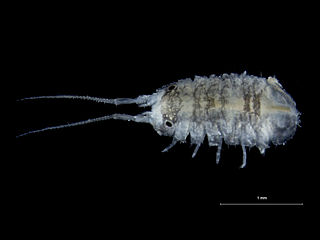
Janiridae is a family of isopods in the order Isopoda. There are more than 20 genera and 190 described species in Janiridae.
Pudeoniscidae is a family of malacostracans in the order Isopoda.

Bathyporeiidae is a family of amphipods in the order Amphipoda. There are two genera in Bathyporeiidae:

Helleria brevicornis, the sole species of the monotypic genus Helleria, is a terrestrial woodlouse endemic to the islands and coastal regions of the northern Tyrrhenian sea. H. brevicornis is of interest due to its endemism, unique ecology and basal position in the suborder Oniscidea.

Chydoridae is a family of water fleas in the order Anomopoda. There are more than 50 genera and 520 described species in Chydoridae. A lot of Chydoridae species are non-native species, many of which pose a great threat to aquatic ecosystems.
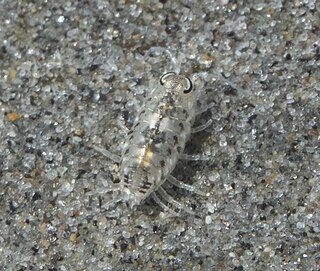
Scyphacidae is a family of woodlice in the order Isopoda. There are about 7 genera and more than 30 described species in Scyphacidae.

Halophilosciidae is a family of woodlice in the order Isopoda. There are at least 3 genera and more than 30 described species in Halophilosciidae.
Anuropus is a genus of isopods in the suborder Cymothoida. As of 2021, it is the only genus in the family Anuropidae.

















